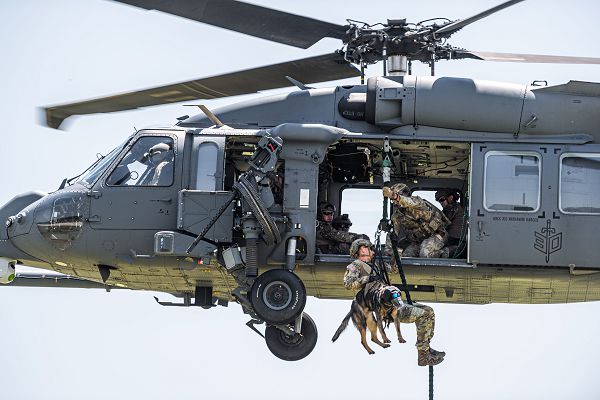
Moody Air Force Base, Georgia. (July 25, 2023): In this photo by Air Force Captain Katie Tamesis, a 45th Security Forces Squadron military working dog handler and K9 partner conduct fast rope insertion and extraction training from a HH-60W Jolly Green II helicopter. The 45th Security Forces Squadron, based at Patrick Space Force Base, came to the 93rd Air Ground Operations Wing headquarters at Moody AFB to train with the 820th Base Defense Group. The goal was to bolster air mobility employment capabilities of military working dog teams.
Most dog owners have witnessed their pet’s fear and anxiety brought on by sudden loud noises like thunder or fireworks on the 4th of July. There are even companies that sell “thunder shirts” to calm pets during these noisy events.
Which begs the question; “How in the world do these military K-9 teams get their dogs to join them as they fast rope to the ground amid the roar of helicopter blades and bombs exploding all around?”
That is the specialty of the Air Force Dog Handler Team program which trains the 1300 working dog teams worldwide including those from the Army, Navy, and Marine Corps. In addition to traditional explosives and drug detection duties, the Dog Handler Team Program exposes K-9s to the sight, sound, smell, feel, and raw environment of a helicopter while its handler rappels the team to the ground.
The teams begin by familiarizing their dog with the entry and exit of the aircraft and, once they are comfortable with moving in and out of the chopper, the pilot fires up the engines and the real challenge begins. Both working dogs and handlers are equipped with hearing protection and as they practice boarding and exiting the chopper multiple times before the helicopter blades come to a stop.
Repeating this procedure, hundreds of times, results in dogs that do not fear the noise and chaos of insertions by air and are ready to join deploy with their unit in combat. Of course, this requires a very special dog and an enormously resolute, and patient, handler.
Becoming a dog handler in the Air Force requires completing basic training and then attending the Military Working Dog Handler Course, which lasts approximately 11 weeks, after which they are assigned to a base where they will continue their training with military working dogs.


